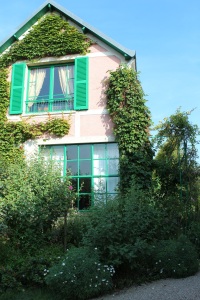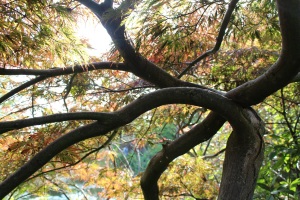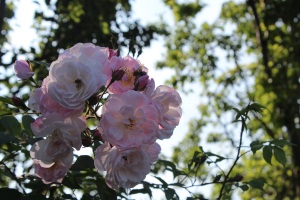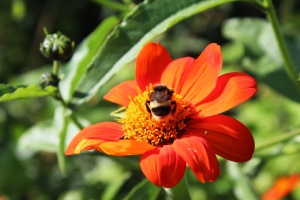If you can manage to find your way around Gare St. Lazare and actually manage to get some kind of ticket for Vernon then you must be some kind of wizard. Never underestimate the overwhelming confusion of foreign train stations. We ended up missing our train by about thirty seconds and had to wait around for two hours for the next one. Oops! That being said having to walk to the nearby Eglise de la Trinité courtyard and eat sandwiches while chatting on a lovely Saturday afternoon isn’t that bad at all. The train ride from Paris to Vernon is quite fast if you get a direct train (under an hour) and the trains themselves are pretty nice, which is definitely reflected in the price.
We arrived in Vernon and, like everyone else on the train, headed for Monet’s estate in Giverny. There are a number of coaches and city buses that shuttle people to and from Giverny (just outside Vernon) but hoping to avoid some of the crowds we decided to walk. Through Vernon the streets are still very old and narrow, and despite heaving bombing during WWII many of the buildings have been maintained since medieval times.
There are a number of memorials in Vernon commemorating the Second World War, the resistance movement and the liberation of Vernon. In correspondence with D-Day the Seine-Loire bridges were bombed so that German reinforcements and supplies would be impeded. The resistance movement in Vernon had succeed in driving the Germans out but were still under siege from across the Seine in Vernonnet. They held out until British troops arrived whose engineers hastily made a pontoon bridge allowing troops to cross and liberate Vernonnet. There were a number of bouquets laid on the memorials and the memory of the event is still honoured today.
Crossing the Pont Clemenceau across the Seine, there are nice shaded footpaths and bike paths that go across and down the river, sandwiched between the sprawling banks and the parallel foothills. Finally arriving at Giverny, passing the ancient church and small houses, now converted B&B’s due to the influx of tourists, ducking between the tidy gated yards and wild french poppies, we waited patiently in the long entrance line.
Monet’s house had fallen into a state of disrepair after his death in 1926. The estate had been left to Monet’s son Michel who then bequeathed the estate to the French Academy of Fine Arts in 1977. The estate and gardens were restored to their historical state and opened to the public. The house itself, that which you are allowed to visit, is set up in a way that is confusing and awkward and cannot handle the massive amounts of visitors. However, if you can stand to, linger around and check out the amazing collection of Japanese prints.
‘In the West what we admired most of all was this bold way of cropping images; these people taught us to compose differently’, Monet told the Duc de Trévise. The Impressionists’ preference for a light tonality, for treating forms in bold masses, for abruptly juxtaposing patches of colour, and for suppressing unnecessary detail had an echo, or found its justification, in these Japanese prints. So did the screen-like, ‘open’ character of Monet’s compositions. In Japan, the genre of woodblock prints that so affected the Impressionists was called Ukiyo-e – ‘pictures of the floating world’. When Monet laid out his water garden at Giverny, his entire concept was Japanese-inspired – it too was a ‘floating world’. The green, humpbacked bridge over the waterlily pond (The waterlily pond 1900) seems to have had a Japanese prototype, possibly suggested by Utagawa Hiroshige’s woodblock print (Inside Kameido Tenjin shrine Japan, Edo period 1856). Hiroshige (1797–1858), an excellent landscapist, was also attracted to novel, fleeting effects” 1.
I’m not sure the Monet Foundation has the rights to the prints and there is no photography allowed in the building. The collection was the most complete, stunning collection, particularly of Hiroshige Ando, as well as some Hokusai and other lesser known Ukio-e artists that I have seen!
Outside the building there are amazingly large, full and sprawling gardens that Monet designed and subsequently hired seven gardeners to maintain. This time of year there are lots of late-bloomers showing off, especially the dahlias, of which there were dozens of varieties. There were lots of favourites that I got to enjoy, such as anemone, scabiosa, clematis, asclepia, celosia, soldiago, zinnias, fuschia, marigold, lady’s mantle, echinops, cosmos, gomphrena, saggitaria, papyrus, cosmos, hollyhocks, and snaps. The camellia bushes were extraordinarily large, though sadly the flowers weren’t open yet. There were also an amazing array of roses: tea roses, garden roses, climbing roses.. all to amazing heights and scents. Of course there were impressively huge and elegant japanese maples and weeping willows.
The loveliest of all though are really they dahlias. There were so many varieties, with colours ranging from the palest blush to the most vibrant orange or deep blood-red.. and in every size imaginable. There were small almost spheres tightly packed with millions of petals, or enormous “dinner plate” dahlias whose amazing show of petals on such a fragile stem is really amazing. I really love these flowers and it was such a joy to be able to see them in such a lovely and plentiful array.
There were a few other that are more rare and I am not accustomed to seeing often, such as nerine, cuphea, oleander, campanula, genistra (what an amazing smell!), azalea, foxglove, nasturtium, and verbena bonariensis. There were also amazing late-blooming giant crosus dappled in the grass, the tallest grove of bamboo I have ever seen, and the lovely abyssinian gladiolus, which is often marketed back home as an orchid.. it’s not!
Of course there were also more common ones that are classics for a reason.. and these were surely fine specimens! Asiatic lilies, phlox, pampas grass (the most impressive!) begonia, geranium, heuchera, hyrangea, ipomoea, rudbeckia, aster, sedum, ruscus, salvia, lambs ear, and of course the coveted and jovial sunflower (tournesol).
The majority of the tourists head straight for the water-lilies and japanese bridge, as these are some of the most famous aspects of Monet’s work. But if you take a stroll between the towering rudbeckia and butterfly-enticing asclepias, you will find many a gentle and nodding flower awaiting your happy gaze. You can also find buzzing bees, fancy chickens and if you’re quiet enough, fieldmice.
Heading home from sleepy Giverny, we had to take a few transfers on the train but managed to make it back to the city without incident. From Gare St. Lazare we went to the west edge of town to meet some friends to watch the Grand Feu d’Artifice, or Big Fireworks! It’s supposedly the largest display in Europe. So, we stood on the Pont de Saint-Cloud and watched the brilliant display. All in all, a pretty good day for eye candy!

1 http://collections.tepapa.govt.nz/exhibitions/monet/monetslife.japaneseart.aspx
















